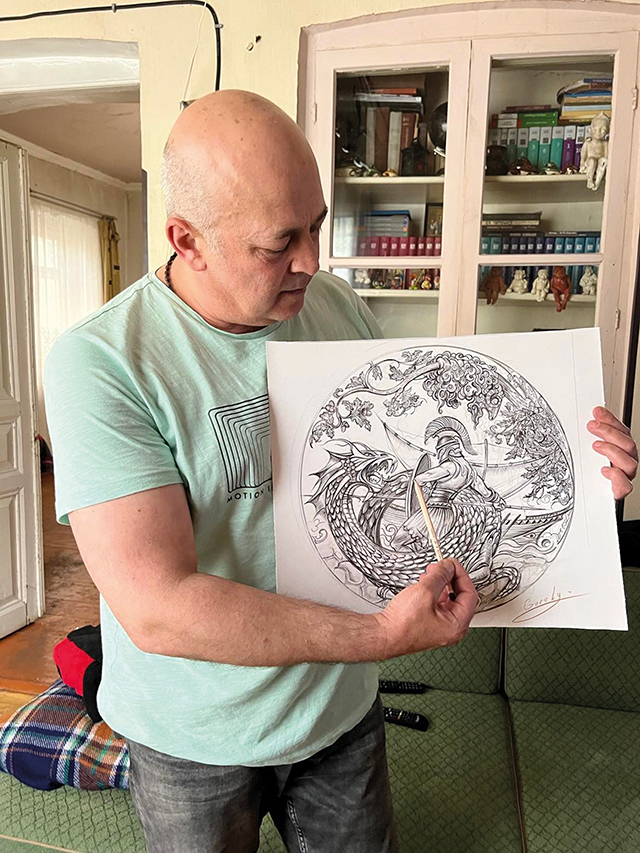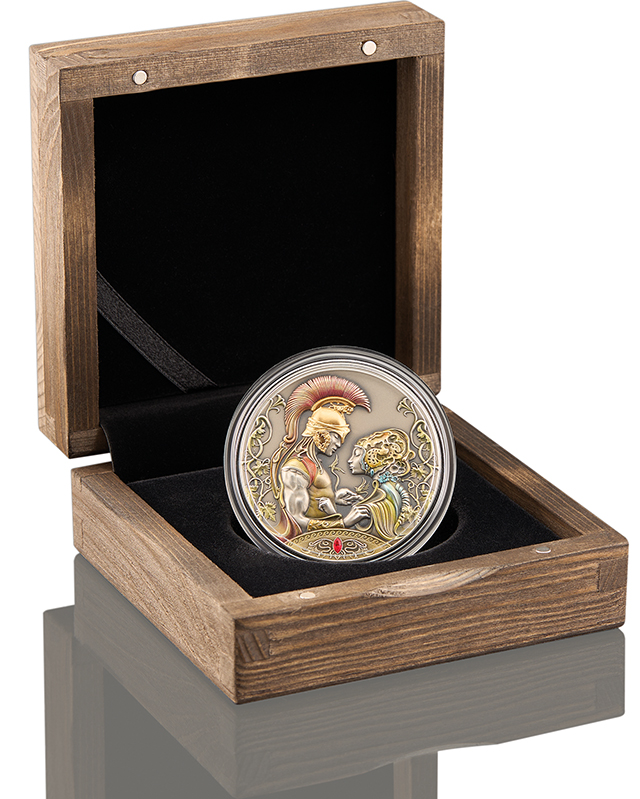Georgian numismatics this past two years has marked an unprecedented success: for the first time, foreign coins with the Georgian-Greek theme ‘Medea and the Golden Fleece’ and Rustaveli’s epic poem ‘The Knight in the Tiger’s Skin’ were minted by the Lithuanian Mint. On the obverse of each coin, a portrait of HM Queen Elizabeth II is featured, adding further historical value to each.
This is the first project of this scale to be implemented in the history of Georgian numismatics, seeing a Georgian-themed coin minted in a foreign country and a Georgian designer creating such a project implemented abroad.
The author of the artworks that were transformed into coins for Medea and Jason’s tale is renowned Georgian contemporary illustrator, painter and graphic artist, Kakhaber Topchishvili, whose works decorate the exhibition spaces of the Zimmerli and Harvard museums, as well as the Moscow Museum of Modern Art. His paintings also adorn numerous private collections. Today, Kakhaber heads the Ana Peradze Art School in Gori, raising future generations of talented Georgian artists and contributing to the development of modern Georgian painting.

Another great Georgian artist whose work has been made into eternal mementos by Lithuanian Mint is Mamuka Mikeladze, who designed scenes from The Knight in the Tiger’s Skin – ‘The Coronation of Tinatin,’ and ‘Tariel Fighting the Wild Beasts.’
GEORGIA TODAY spoke to Ruta Mikaliukštyte, Project Manager at Lithuanian Mint, to find out how the collaboration and promotion of Georgian art and legends began, and where it will be going next.
The aim is to depict art and history on coins. We are extremely grateful to the Georgian artists for their cooperation and talent
“The strategy of Lithuanian Mint was changed in 2019. Before that, the company mainly worked to customer order,” she tells us. “Today, we not only work on customer orders but also successfully implement and develop our own projects. The company now has full capacity, upgraded processes and responsibilities, and is able to successfully promote its projects globally.
“Lithuanian Mint pays particular attention to product development, preparation work, and quality, as well as being constantly on the search for new technological solutions. This is why we cooperate with qualified partners, designers, and sculptors around the world. The smooth development and implementation of novel, exclusive products are a merit of our excellent team.”
The latest projects in the Lithuanian Mint are already present on the market, and around 40 projects have been planned for 2021-2022. Some of their editions have already sold out.

“Our joint and first Lithuanian-Georgian cooperation project started in 2021 with the theme of ‘Medea (The Myth of Love),’” Mikaliukštyte says. “We are extremely grateful to the Georgian author Kakhaber Topchishvili for his cooperation and his talent. This is the main thing – to depict art and history on coins. We also started two new coin series with him this year- ‘Women’ and ‘Gods and Goddesses,’ which will be developed throughout the year and into 2023. We are honored to work with such a talented author.”
What inspired you about the two Georgian legends Medea and The Golden Fleece, and The Knight in the Tiger’s Skin?
For us, that Georgia is associated with legendary gold in the myth, alongside the discovery of one of the oldest gold mines and facilities for processing gold in Sakdrisi, Georgia, is considered a spectacular achievement of today’s archaeological research in the country.
New findings prove the outstanding significance of gold mining for the civilization of early Georgia and, once again, are evidence the country’s early richness in gold, which found its reflection in the legend of the Golden Fleece.
Georgia is associated with legendary gold in the myth, which is only added to by the discovery in Georgia of one of the oldest gold mines and facilities for processing gold
Medea and Jason represent a dramatic, sexy and colorful story. It is an interesting story to listen to, and especially to discover on a collectable coin.
The Knight in the Tiger’s Skin epic poem is widely regarded to be the meeting point for Georgian philosophy, art and thought. Rustaveli composed the poem during the Georgian Golden Age, when everything in Georgia was thriving and at its peak. Even the natural world seemed positively affected by Queen Tamar and her rule.
Rustaveli is considered to be one of Georgia’s greatest ever literary influences, and The Knight in the Tiger’s Skin is the national poem of Georgia even today – and that’s why it inspired us for a collectible coin series.
Were the Georgian-themed coins popular?
We have already sold them in Canada, France, Poland, Germany, Czech Republic, Italy, Spain, Poland, the USA, Lithuania and, of course, Georgia.
How are the coins made, and with what materials? How many people are involved in the process?
The project has its own project manager, but all employees in the company work on the process – we are a team. Not only the initial design, but the minting process itself requires precision and attention to detail, and must be implemented according to stringent requirements for dyes, tips, and pressure tolerance. The work methods we employ ensure the production of premium products.
Not only the initial design, but the minting process itself requires precision and attention to detail, and must be implemented according to stringent requirements
Both long-term employees, who share their experience, and enthusiastic new employees are the company’s most important asset, guaranteeing the best performance- they are our driving force and strength.
Our collectible coins are mostly minted from silver and gold. We use special technologies such as gilding and UV printing. We recently introduced a new technology for partial variation, and are constantly looking for new ones.
What projects are upcoming in 2022/2023?
Kakhaber Topchishvili has been working on the ‘Women’ series to honor the most prominent ladies who have become global inspirations. The first coin in the series – a piece dedicated to one of the most famous English monarchs, Elizabeth I, is out already. She’ll be followed by Florence Nightingale. He is also working on ‘Gods and Goddesses’ for us, and has already sent us his designs for Isis, Bacchus and Poseidon, with more on the way!
GEORGIA TODAY next spoke to designer Kakhaber Topchishvili.
“Ancient myths have a big place in all my work,” he tells us. “I was always fascinated by the great love story of Medea and Jason. I was born in the Soviet era, but inside I always felt that Georgia was part of Europe. Palaces, Georgian achievements of the civilization of the same period, the fact that Georgia shared the unique technology of gold mining with the rest of Europe. Unfortunately, due to its geographical location, my homeland withstood a lot of attacks, while the rest of Europe was always shielded.

“Given the opportunity to have a Her Majesty Elizabeth II coin depict any of the themes I have chosen is a great honor, and I took the opportunity to capture the story of my favorite mythical Georgian woman, Colchis Medea, with her glorious unrequited love for Jason.
“I took as my inspiration my beautiful wife Thea, whose classical profile slowly transformed on paper into Medea’s face. For me, this coin has a sacral weight, and, if taken as confirmation of Georgia’s deserving European membership and its breaking out of the vicious circle we currently find ourselves in, then it is a symbol of a happy ending and also makes a brilliant gift for newlyweds!”
Georgian Gold
The inspiration for the designs for the Medea series comes from the legend of the Argonauts, the 50 Greek warriors who, legend says, went to Colchis (an exonym for the Georgian polity of Egrisi located on the coast of the Black Sea, in present-day western Georgia), along with their leader Jason, to take the Golden Fleece. Medea, the daughter of King Aeëtes of Colchis, a beautiful sorceress, aids Jason in his search for the Golden Fleece out of love, assisting him with her magic and saving his life on several quests. She then abandons her home and flees with him to Corinth, where the two marry.
The ancient Kingdom of Kolkheti comprised the land bounded by the Black Sea to the west, the Caucasus Mountains to the north, the Surami Range to the east and the Meskhetian Mountains to the south. Today, the area is part of Georgia.
The Kolkhetian people flourished and developed an expertise in the smelting and casting of metals long before this skill was mastered in Europe. As the Kolkhi society and culture thrived, it attracted the attention of Greek traders and adventurers who traveled to the kingdom to seek out the rich natural resources, including gold.
The Kolkhi people developed a unique way to prospect for gold. A sheep’s fleece was attached to a wooden support and left in a fast flowing mountain stream, resulting in particles of gold collecting in the wool. The fleece would then be hung in a tree to dry before the gold was shaken or combed out.
This technique for collecting gold may have given rise to the legend of Jason and his quest for the Golden Fleece.
The Greek historian Strabo (44 B.C.-23 A.D.) mentioned the Kingdom of Kolkheti in his Book IX of Geography:
“In the mountain rivers of this country there is a lot of gold mined by these barbarians using perforated vessels and sheepskin.”
This gives rise to the theory that rather than stealing a golden fleece, Jason may have been looking for a method of panning for gold that is still used today in some parts of the Caucasus Mountains.
The ancient Roman historian Appian (90-170 A.D.) appears to corroborate this theory. In his Book XII “The Argonauts Voyage to the Kingdom of Kolkheti”, he considers the main aim of the expedition was to obtain the sheepskin method of gold mining. Prospecting for gold still takes place in the Inguri River in Svaneti on the southern slope of the Greater Caucasus Mountains. Some prospectors still mine gold from rivers using sheepskin and special wooden vessels.
From January to March, the freezing cold waters of the Inguri River are low enough to let prospectors pan for gold.
Svan gold prospectors claim they can expect to extract about 30-40 grams of gold over the course of the three-month prospecting season. [Source: Georgia About]
By Katie Ruth Davies














